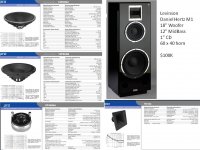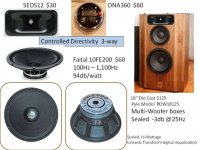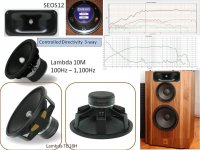hi,
i ask this as a very vague question deliberately to get the greatest range of 'ideas' and opinions i can.
if you were to take a large PA woofer, say 18" which typically have 4" voice coils. can these be modified in such a way that allows a compression driver to be fitted and thus converted into a coax?
i'm not 100% sure on the specific construction of drivers when it comes to how the magnet fits the voice coil. does a typical driver have some sort of 'hollow' section that can be used to load a compression driver? i know there's a few PA woofers that have vented pole sections, can this be used as the initial horn section for a compression driver, then venting into an external horn section?
I have some woofers with no use now (ebay buys that didn't cut it) which i wanted to try and find some use out of.
thanks for your help.
i ask this as a very vague question deliberately to get the greatest range of 'ideas' and opinions i can.
if you were to take a large PA woofer, say 18" which typically have 4" voice coils. can these be modified in such a way that allows a compression driver to be fitted and thus converted into a coax?
i'm not 100% sure on the specific construction of drivers when it comes to how the magnet fits the voice coil. does a typical driver have some sort of 'hollow' section that can be used to load a compression driver? i know there's a few PA woofers that have vented pole sections, can this be used as the initial horn section for a compression driver, then venting into an external horn section?
I have some woofers with no use now (ebay buys that didn't cut it) which i wanted to try and find some use out of.
thanks for your help.
Is there a reason to do this instead of:
A. Build a regular 2 way
B. Mount a tweeter on a frame in front of the dustcap?
A. Build a regular 2 way
B. Mount a tweeter on a frame in front of the dustcap?
hi,
i ask this as a very vague question deliberately to get the greatest range of 'ideas' and opinions i can.
if you were to take a large PA woofer, say 18" which typically have 4" voice coils. can these be modified in such a way that allows a compression driver to be fitted and thus converted into a coax?
i'm not 100% sure on the specific construction of drivers when it comes to how the magnet fits the voice coil. does a typical driver have some sort of 'hollow' section that can be used to load a compression driver? i know there's a few PA woofers that have vented pole sections, can this be used as the initial horn section for a compression driver, then venting into an external horn section? [/b ]
Take some time researching design and construction of drivers - there should be no shortage of graphics on the subject.
To the question - even though Cal has far more experience with biggazz drivers than many of us splashing around here in the kiddie pool, I suspect the short answer would be for several reasons: NO
- if the voice is vented, it's gonna be for cooling purposes; blocking it would likely diminish the power handling capacity, as well as affect the mechanical aspect of T/S parameters
- unless specifically engineered for the purpose, the likelihood of any taper in the vent being correct load for a compression driver would be slim to none
OTOH, there have been many examples of small dome tweeters fitted atop solid magnet pole piece - wood dowel, etc. , or suspended by thin wooden or formed metal straps attached to main driver mounting bolts (Cal's item B above)I have some woofers with no use now (ebay buys that didn't cut it) which i wanted to try and find some use out of.
thanks for your help.
all this is conjecture on my part - I've just never been interested enough to pursue the latter
Agree and add: actual modifying an existing speaker requires demagnetizing it, somehow pulling the pole piece, or removing the backplate if they can't be separated, turn it in a lathe so you have a proper horn section hole, thread it to be able to mount a driver, refinish (galvanizing or phosphate+paint), rebuild the magnet assembly and remagnetize.
Don't forget you'll lose the vent (because now it will be blocked by the driver).
And you will probably have a big hole in the frequency response.
The lower limit of any horn you can turn into that pole piece and the high limit of that big heavy woofer will be quite far away.
Who will reproduce that missing but very important mid band?
50's coax speakers (Jensen/Altec/Tannoy/etc.) could get away with it because they used very thin and light cones which reached quite high, even 5 or 6 KHz, so the horn loaded tweeters didn't need to reach lower than that.
Don't forget you'll lose the vent (because now it will be blocked by the driver).
And you will probably have a big hole in the frequency response.
The lower limit of any horn you can turn into that pole piece and the high limit of that big heavy woofer will be quite far away.
Who will reproduce that missing but very important mid band?
50's coax speakers (Jensen/Altec/Tannoy/etc.) could get away with it because they used very thin and light cones which reached quite high, even 5 or 6 KHz, so the horn loaded tweeters didn't need to reach lower than that.
i ask this as a very vague question deliberately to get the greatest range of 'ideas' and opinions i can.
.
Life demands many compromises. ... your speakers do not need to be one of them.
Consider building a high efficiency 3-way speaker. An 18" woofer requires a large cabinet to generate deep bass, and adding a midbass and small SEOS waveguide tweeter will increase this volume by about 30%. You could also build a bass box and seperate Econowave midbass+waveguide box. These options are smaller than an 18" box plus a LARGE horn covering 500Hz and above.
The Econowave projects combine a 10" - 12" midbass with a SEOS waveguide and 1" compression driver for controlled directivity DYNAMIC SOUND. There are many positive reviews.
I built a home theater center channel using a 15" Lambda TD15M with a SB29RDCN dome tweeter attached to the large phase plug with a section of rubber bicycle intertube. A great vocal range center channel, but a poor full range.
Attachments
- Status
- Not open for further replies.


